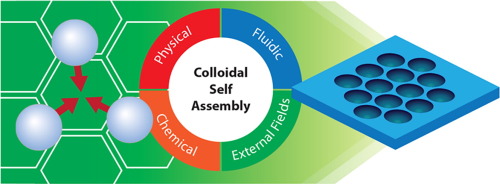Advances in Colloid and Interface Science ( IF 15.9 ) Pub Date : 2017-11-08 , DOI: 10.1016/j.cis.2017.10.007 Ryan van Dommelen , Paola Fanzio , Luigi Sasso

|
The controlled patterning of polymeric surfaces at the micro- and nanoscale offers potential in the technological development of small-scale devices, particularly within the fields of photovoltaics, micro-optics and lab- and organ-on-chip, where the topological arrangement of the surface can influence a system's power generation, optical properties or biological function - such as, in the latter case, biomimicking surfaces or topological control of cellular differentiation.
One of the most promising approaches in reducing manufacturing costs and complexity is by exploitation of the self-assembling properties of colloidal particles. Self-assembly techniques can be used to produce colloidal crystals onto surfaces, which can act as replicative masks, as has previously been demonstrated with colloidal lithography, or templates in mold-replication methods with resolutions dependent on particle size. Within this context, a particular emerging interest is focused on the use of self-assembled colloidal crystal surfaces in polymer replication methods such as soft lithography, hot and soft embossing and nano-imprint lithography, offering low-cost and high-resolution alternatives to conventional lithographic techniques.
However, there are still challenges to overcome for this surface patterning approach to reach a manufacturing reliability and process robustness comparable to competitive technologies already available in the market, as self-assembly processes are not always 100% effective in organizing colloids within a structural pattern onto the surface. Defects often occur during template fabrication. Furthermore, issues often arise mainly at the interface between colloidal crystals and other surfaces and substrates. Particularly when utilized in high-temperature pattern replication processes, poor adhesion of colloidal particles onto the substrate results in degradation of the patterning template. These effects can render difficulties in creating stable structures with little defect that are well controlled such that a large variety of shapes can be reproduced reliably.
This review presents an overview of available self-assembly methods for the creation of colloidal crystals, organized by the type of forces governing the self-assembly process: fluidic, physical, external fields, and chemical. The main focus lies on the use of spherical particles, which are favorable due to their high commercial availability and ease of synthesis. However, also shape-anisotropic particle self-assembly will be introduced, since it has recently been gaining research momentum, offering a greater flexibility in terms of patterning. Finally, an overview is provided of recent research on the fabrication of polymer nano- and microstructures by making use of colloidal self-assembled templates.
中文翻译:

胶体晶体的表面自组装,用于微和纳米构图
微米级和纳米级聚合物表面的受控图案化为小型设备的技术开发提供了潜力,特别是在光伏,微光学以及芯片实验室和器官组织领域,在这些领域中,表面可能会影响系统的发电,光学特性或生物学功能-例如,在后者的情况下,是仿生表面或细胞分化的拓扑控制。
降低制造成本和复杂性的最有前途的方法之一是利用胶体颗粒的自组装特性。自组装技术可用于在表面上产生胶体晶体,该胶体晶体可以用作复制掩模,如先前用胶体光刻技术所证明的那样,或者是模具复制方法中的模板,其分辨率取决于颗粒尺寸。在此背景下,特别引起关注的是在聚合物复制方法中使用自组装胶体晶体表面,例如软光刻,热和软压花以及纳米压印光刻,提供了常规方法的低成本和高分辨率替代品光刻技术。
但是,这种表面构图方法要达到与市场上已有的竞争技术相当的制造可靠性和工艺鲁棒性,仍需克服挑战,因为自组装过程并不总是100%有效地将结构图中的胶体组织到表面上。表面。在模板制造过程中经常会出现缺陷。此外,问题通常主要出现在胶体晶体与其他表面和基底之间的界面处。特别是在高温图案复制工艺中使用时,胶体颗粒在基材上的附着力差会导致图案模板的降解。
这篇综述概述了可用于形成胶体晶体的自组装方法,该方法由控制自组装过程的力的类型来组织:流体,物理,外场和化学。主要焦点在于球形颗粒的使用,由于它们的高商业可用性和易于合成,这是有利的。但是,还将引入形状各向异性粒子自组装,因为它最近获得了研究动力,在构图方面提供了更大的灵活性。最后,概述了利用胶体自组装模板制备聚合物纳米结构和微结构的最新研究。











































 京公网安备 11010802027423号
京公网安备 11010802027423号